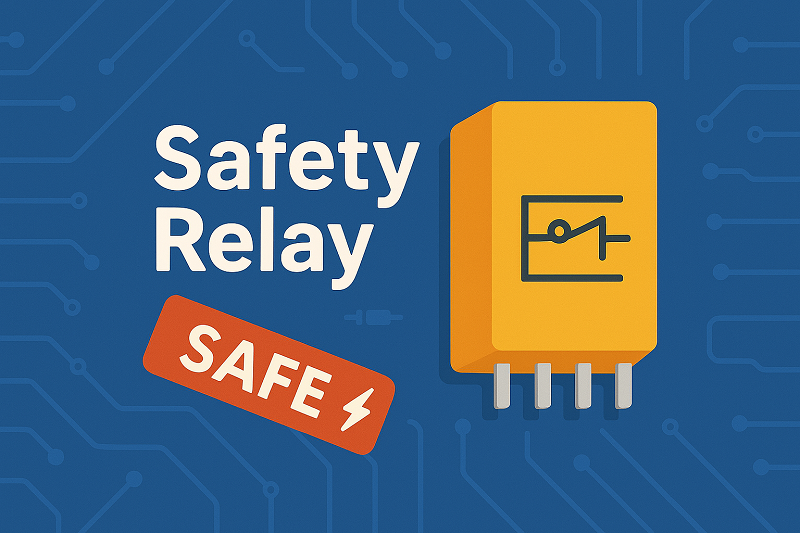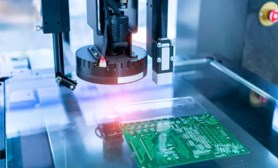Domestic Induction Solution using SSR-Based Power Semiconductor Devices
| Topics covered in this article: |
| Ⅰ. Bi-Directional Switches (BDS) in Solid State Relays |
| Ⅱ. Implementing BDS Solutions |
| Ⅲ. Characterization and Results |
| Ⅳ. Conclusion |
Despite significant advancements in medium-power industrial solid-state relay (SSR) solutions, challenges persist in home appliance induction heating. This process involves a two-stage power conversion: rectifying AC voltage through a diode bridge, then feeding the DC bus voltage (VBUS) into inverters for high-frequency current to induction coils. Conventional induction setups with multiple loads face limitations due to separate inverters for individual power needs. The loads-multiplexing technique uses time-multiplexed Single-Pole, Double-Throw (SPDT) Bi-Directional Switches (BDS) for parallel operation of diverse loads (Leq,1, Leq,2, etc.) resonating with capacitor banks, as seen in Figure 1.

Fig 1 Schematic of an induction heating system
Electro-Mechanical Relays (EMRs) are cost-efficient for low on-state resistance (5-10 mΩ) power sub-circuit blocks. However, their use is limited by voltages/currents exceeding 400 VAC/20~30 A. These challenges highlight the urgency of semiconductor-based designs to optimize system efficiency. The transition from EMRs to advanced SiC/GaN-based devices promises enhanced performance, voltage/current handling, and power multiplexing, propelling SSR solutions for medium-power industrial applications, particularly in induction heating for modern home appliances.
Ⅰ. Bi-Directional Switches (BDS) in Solid State Relays
Some of the BDS solutions that are in the voltage and current ranges of interest are as follows:
A. Single device: Standard TRIACs offer a Built-In Snubber (BDS) with low on-state losses (around 1.15 V at 30 A for an 800 V device). But they have limitations in turn-off behavior for commutating on-state current (dI/dt)C. Snubberless TRIACs have improved compatibility with 50-60 Hz applications but still fall short for specific needs.
B. Multiple power devices: Currently, reverse-blocking IGBTs (RB-IGBTs) are the sole commercially available devices with monolithic integration of modified IGBT structures and reverse-blocking capabilities. Operating at 600 V, these RB-IGBTs offer saturation voltages (VCE(sat)) of approximately 1.5 V at 30 A. Alternatives in the 650 V range include trench IGBTs paired with anti-parallel diodes for low VCE(sat) (<1 V at 30 A), reverse conducting IGBTs (RC-IGBTs) with embedded diodes (VCE(sat) ~1.25 V at 30 A), and Silicon (Si) based planar MOSFETs or Si SuperJunction (SJ) MOSFETs, known for lower on-resistance and conduction losses than IGBTs. Emerging Silicon Carbide (SiC) devices and Gallium Nitride High Electron Mobility Transistors (GaN HEMTs) are gaining traction, offering smaller chip sizes, lower on-resistance, and higher power densities. The choice of device depends on specific application needs, with the potential for monolithic GaN BDS as a promising future option.
Ⅱ. Implementing BDS Solutions
Figure 2 depicts the common structure shared by the analyzed test vehicles. They rely on two primary inputs: a control signal (VIN = 0 V / 5 V) and an external power supply (VAC). These inputs feed into the BDS (Bridge Diode Switch) power terminals, which are electrically isolated from the inputs. The operation of these test vehicles varies based on factors like the number of power devices, their arrangement in the BDS, and their driving requirements (e.g., voltage/current control, normally-on/normally-off modes). Consequently, unique driving circuitry is designed for each solution.

Fig 2 Block diagram of the test vehicles.
The study investigates thirteen implementations using various semiconductor technologies. TRIACs, considered as a reference, are controlled using standard IGBT drivers, despite having higher control losses and power supply needs (1 W). Cascodes, IGBTs, and MOSFETs-based BDSs exhibit low control losses with only two 200 mW power supplies. However, RB-IGBT BDS demands individual drivers and power sources for each device, increasing control complexity, losses, and costs. SiC MOS FETs require non-standard power sources, elevating control complexity and costs. Different voltage power supplies are employed to bias gate opto-coupled drivers, producing a gate control signal (VCON) that enables or disables the power stage devices. Overvoltage protection for gate and power stages is integrated, along with a zero-current detection system to ensure safe operation.
GaN HEMTs and SiC JFETs-based BDSs feature low control losses (two 50 and 100 mW power supplies) but require specific gate drivers and opto-couplers due to unique driving voltages. GaN HEMTs offer monolithic integration capabilities, but both technologies require additional safety measures like TVS for overvoltage protection. SiC BJTs necessitate substantial gate currents, leading to high control losses (10 W power supply) and the need for separate opto-couplers and drivers.
Ⅲ. Characterization and Results
In the analyzed application framework, conduction losses are predominant due to low switching frequencies of the BDSs. Static I-V curves are obtained using a TEK 371A curve tracer for each BDS test vehicle in forward and blocking modes, utilizing bare die areas measured with a Sonoscan GEN-5 Scanning Acoustic Microscope. These curves provide static current densities (JD) and JD-VBDS profiles. All solutions considered are suitable for BDS implementation, but bipolar devices exhibit a slight offset voltage, potentially causing minor AC current/voltage distortion at the BDS in the zero-crossing region and increased power losses. Conversely, HEMTs, MOSFETs, and JFETs offer symmetrical conduction in the first and third quadrants.

Fig 3 Schematic of the test setup.
In a functional BDS, as IBDS approaches zero and VBUS begins, parasitic RLC elements may induce oscillations. These oscillations, determined by device output capacitances (Coss), vary in amplitude and frequency, explaining slower devices' lower oscillation frequencies. The SiC BJT+SiC Schottky Diode BDS experiences minimal voltage oscillations during blocking but exhibits a current peak due to BJT reverse recovery. Integration into a single chip could reduce this peak. RB-IGBTs and SiC/GaN-based BDS exhibit good dynamics, with GaN HEMTs offering excellent performance, making them a cost-effective mid-term replacement for EMRs.
Ⅳ. Conclusion
An experiment demonstrated the feasibility of advanced power semiconductor devices as alternatives to EMRs in home appliances. Various solutions met the necessary I-V static characteristics for BDS functionality, with SiC JFETs, SiC MOSFETs, and GaN HEMTs-based BDSs outperforming others due to their minimal conduction voltage drops. SiC JFETs showed even greater potential if more switches were available. GaN HEMTs emerged as the top EMR replacements, primarily due to their superior performance, especially when considering potential monolithic integration.
 What is Time Delay Relay?UTMEL11 October 202110649
What is Time Delay Relay?UTMEL11 October 202110649Hello everyone, I am Rose. Today I will introduce Time Relay to you. A Time Relay is an electrical component that is used on a circuit with a lower voltage or lower current to turn on or off a circuit with a higher voltage and bigger current or to regulate a higher voltage or larger power. This article will introduce some basic knowledge of Time Relay.
Read More What is Safety Relay?UTMEL12 April 202522393
What is Safety Relay?UTMEL12 April 202522393Safety relays represent a critical advancement in industrial automation technology, serving as essential components in machine safety systems. Unlike standard relays, safety relays are specifically engineered to provide reliable protection in potentially hazardous environments. This article explores the fundamental aspects of safety relays, including their operational principles, wiring configurations, and proper implementation methods in industrial settings.
Read More What is Relay?UTMEL15 November 20215204
What is Relay?UTMEL15 November 20215204Hello everyone, I am Rose. Welcome back to the new post today. Relay is an autonomous electrical appliance used in electric drive systems for control, protection, and signal conversion. It is suitable for remote connection and disconnection of AC and DC small-capacity control circuits.
Read More AC Contactor: What is Self-Locking?UTMEL01 March 20229431
AC Contactor: What is Self-Locking?UTMEL01 March 20229431AC contactors often use three arc extinguishing methods: double-break electric arc extinguishing, longitudinal seam arc extinguishing and grid arc extinguishing. It is used to eliminate the arc generated by the moving and static contacts during the opening and closing process.This article mainly introduce the principle of AC Contactor self-locking.
Read More Weak Current Control Strong Current: How to use the Relay?UTMEL28 November 20224157
Weak Current Control Strong Current: How to use the Relay?UTMEL28 November 20224157Hello everyone, I am Rose. Welcome to the new post today. Today I will introduce relay to you. Including its definition, parameters, working principle and so on.
Read More
Subscribe to Utmel !
![WSL2010R0330FEA]() WSL2010R0330FEA
WSL2010R0330FEAVishay Dale
![WSL36378L000FEA]() WSL36378L000FEA
WSL36378L000FEAVishay Dale
![DS1E-M-DC24V]() DS1E-M-DC24V
DS1E-M-DC24VPanasonic Electric Works
![ERJ-3EKF22R0V]() ERJ-3EKF22R0V
ERJ-3EKF22R0VPanasonic Electronic Components
![RC0603FR-0720K5L]() RC0603FR-0720K5L
RC0603FR-0720K5LYageo
![WSL2010R0400FEA]() WSL2010R0400FEA
WSL2010R0400FEAVishay Dale
![CRCW1206470RFKEA]() CRCW1206470RFKEA
CRCW1206470RFKEAVishay Dale
![CR0603-FX-2003ELF]() CR0603-FX-2003ELF
CR0603-FX-2003ELFBourns Inc.
![RC0603FR-074K3L]() RC0603FR-074K3L
RC0603FR-074K3LYageo
![ERJ-6GEYJ101V]() ERJ-6GEYJ101V
ERJ-6GEYJ101VPanasonic Electronic Components











